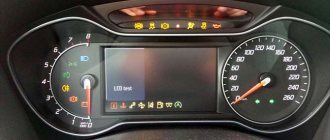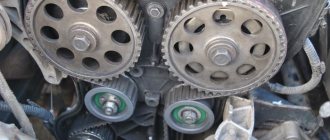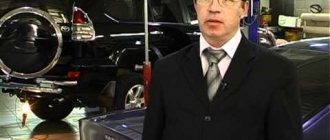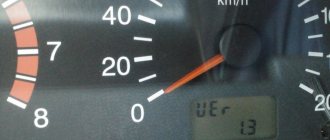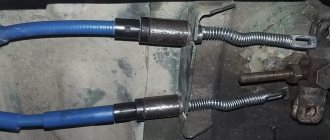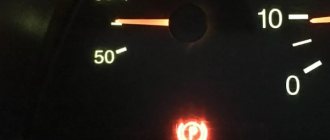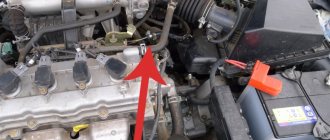Most drivers are familiar with the yellow car engine icon, which lights up when there is a problem with the engine or exhaust system. In descriptions of the instrument panel, the indicator is called “check engine” (translation - “check engine”), it is used to generally indicate malfunctions.
What is a “check engine”: what problems does a burning “check” indicate?
The warning light comes on for the following reason: the engine ECU detects some error or failure and writes the fault into its memory in the form of a specific code. In parallel with this, the control unit initiates the lightning of the check. Let us add that on some cars that have a developed self-diagnosis system, such an error can be immediately deciphered and the data is displayed on the on-board computer screen. Simpler versions of the car will require connecting a special scanner to the diagnostic connector, after which the error code is read for further detailed decoding.
It is worth noting separately that if the check engine light is on when you turn on the ignition, then this is an absolutely normal phenomenon and is not a malfunction. The icon should normally go out after the engine starts, that is, after the internal combustion engine begins to operate independently. A cause for concern is the situation when the engine is running and a lighted check mark is present on the panel after starting.
Let us add that the check engine indicator, in the process of the evolution of electronic systems in the car, has gone from a simple indicator of malfunctions during carburetor injection to a full-fledged indicator of all kinds of problems with the internal combustion engine and equipment. A lit check may indicate an incorrect composition of the fuel-air mixture, malfunctions of the ignition system, malfunctions of the ECM sensors and other problems that may not be related to the engine at all. Taking into account the above, it is clear that there are many reasons for the check engine to light up on a modern car. Determining a particular malfunction may require not only experience and knowledge, but also special equipment.
As already mentioned, the ECU records various errors, after which the check light comes on. This means that the malfunction can be either a serious breakdown or a minor problem. In any case, further operation of the vehicle is not recommended, since the car requires immediate diagnostics. At the same time, experienced drivers can independently determine the cause of the check light without going to a service station or using diagnostic equipment. Let's look at the main symptoms, signs and causes of common faults that cause the warning light to come on.
Reset errors
There are quite a lot of cases when the Check Engine light comes on, and the problem that has arisen should not be ignored. However, after eliminating the problem, the light may still remain on. What does this have to do with?!
After detecting a problem, the ECU stores its code in memory (this has already been mentioned). However, if the situation is corrected, the code cannot go anywhere and therefore the indicator lights up again the next time the engine is started. Here you should erase error codes from the computer's memory. In the language of specialists, this procedure is called resetting error codes. There are several options for how this can be done.
Professional technique
This is the most reliable and effective way to get rid of the annoying indicator when the problem has already been solved. The procedure is performed in a car service center using special equipment. And today there are a lot of such places in every city, not to mention megacities.
Amateur performance
You can find special scanners for cars on sale in relevant specialized stores. Such a device can help out in different situations and therefore this purchase will be very useful for any vehicle owner.
Then the only thing left to do is download the necessary software for your smartphone (tablet or laptop - now every second car enthusiast has such gadgets). By connecting the device to the vehicle's OBD2 diagnostic connector, you can “read” all existing Check Engine errors.
Some software offers an alternative solution to the problem. Most minor breakdowns can be easily resolved by car owners. In other words, buying a car scanner has certain advantages, including savings. Finally, all that remains is to erase the errors, and the check will no longer bother and irritate you.
Originally folk technique
Some craftsmen know very well what to do to reset the error, using their own special method, which every experienced car enthusiast knows about. To turn off the light bulb, just follow a certain sequence:
- Start the engine.
- Open the hood and disconnect the positive terminal of the battery.
- Wait 60 seconds, then return the terminal to its place.
- The error code will be reset, which will be indicated by the indicator light going out the next time you turn on the engine.
- Another procedure may also help:
- Turn on the ignition, wait 3 seconds and proceed to the next step.
- Press the accelerator pedal 5 times, holding each position for 5 seconds. Release the pedal.
- After 8 seconds, press the gas pedal again and hold it for 10 seconds - the indicator will blink.
- Take your foot off the pedal and you can look at the display where error codes are displayed. Now press the accelerator pedal again for 10 seconds - the Check Engine light should go out.
- Turn off the ignition.
- To check, you can start the engine again and make sure that the indicator goes out and does not light up, as it should be.
It is worth noting that the last two methods only work if the problem is fixed. Otherwise, you shouldn’t be surprised that the Check Engine caught fire. And then visiting a specialist is only a matter of time.
Video: Daewoo Matiz. Reset Check Engine Using ELM327 and Torque
general information
There are many reasons why the check engine light comes on. The error appears on the dashboard suddenly and without warning, and it is not easy to determine what led to this. And even if the vehicle is equipped with automatic diagnostic tools, such as in BMW, Porsche, VW or Audi, which scan the vehicle systems for failures, it is impossible to find the source of such an error without a technical inspection.
The check engine sign means absolutely nothing to the average motorist, so you need to visit a service center as soon as possible and check the engine. However, in some cases, you can find the source of the error and eliminate it at home. To do this, you need to understand the key reasons for the notification and how to solve them. Timely diagnostics are a good way to return your car to its previous performance, saving money.
Verification of high-voltage wires
Instructions for use:
- Plain water is poured into a stainless steel container, where salt is then added in the amount of one tablespoon;
- The wires, except the very tips, are lowered into the resulting solution. To check the wires, a megger is used, which is connected to tip number one. The second clamp must be attached to the vessel where the wiring is located.
- If the insulation properties are violated, the resistance will be below a value of five hundred kOhms. Then the wires must be replaced.
There are cases that the described checks and test tasks do not help to identify the specific reason why the “Check Engine” does not go out, but continues to light. In this case, it will not be possible to do without the help of professional craftsmen.
Currently, service stations for the most part are equipped with the latest equipment, so it will not be difficult for them to make a diagnosis and can quickly find the cause. In addition, they will also help resolve it.
The cost of their work must always be listed in the approved price list. The reason may turn out to be ridiculously simple, and fixing it will take very little time and will not require you to spend a lot of money.
However, you should not regret the significant costs if the identified cause turned out to be truly significant, both for the normal operation of the vehicle and for the safety of the driver and passengers.
In any case, you should not leave the “Check Engine” indicator on for too long, as the consequence may be that the car needs to be overhauled.
Situations while driving when the check light comes on
Let's consider several typical situations when a driver needs to urgently respond to the Check engine being turned on:
- When the engine starts, the check light comes on and goes out almost immediately. He did not highlight any serious problems in this situation. Check the gas cap. Most likely it is not screwed on properly.
- The indicator light came on while driving. This situation indicates an electrical circuit break. These could be loose contacts, disconnected wires, including the battery. Check all attachments.
- The indicator flashes when moving. Stop and without turning off the engine, listen to the noise from the engine. You need to check the oil volume. However, this is already a fairly serious call, so you need to get to the auto repair shop as soon as possible.
- The check light blinks, but the engine runs great, no noise is heard, and there are no interruptions. This indicates a malfunction in the ignition system. You should pay attention to the serviceability of the spark plugs and the quality of gasoline.
- And if in the same situation, the indicator lights up continuously. This is a sign of an incorrectly set spark plug gap. Adjust according to the norm (no more than 1.3).
- A constantly glowing Check Engine indicates problems with the ignition system insulation. Have it tested at a diagnostic center.
- The check light comes on when you start driving and does not go out. Faulty fuel pump. Listen to the noise, if you identify characteristic sounds, dismantle it and wash off the dirt from the insides and filters.
- The check engine light is constantly on. This is accompanied by an increase in the temperature of the antifreeze (up to 90 degrees). Here we are talking about serious problems in the engine. It is better to stop driving and call a tow truck to a service center.
What do you do when this light comes on?
The translation of the expression Check Engine indicates the need to check the engine, that is, the electronic control system has detected some problems and informs the driver about it. Its operation is designed in such a way that when you turn the key in the ignition switch, the warning light should light up for a while and go out. At this time, all power unit systems are diagnosed, and an extinguished lamp indicates the absence of any problems.
Today, absolutely all powertrain systems are under electronic control; this is achieved by installing many different sensors. Based on their readings, the unit forms the composition of the air-fuel mixture, sets the ignition timing, controls the composition of exhaust gases and other important parameters. Based on this, we can conclude that there are quite a few reasons why this signal appears.
Engine malfunction indicator: main causes of fire. Methods of their treatment
There are quite a few reasons why the engine diagnostic light comes on, since the signal comes from the on-board computer, which simultaneously analyzes many vehicle operating systems: ignition, automatic transmission, engine, carburetor, etc. Some faults can be diagnosed independently, but first, let's figure it out in their reasons:
- If the engine light comes on, you need to start by checking the tightness of the fuel system, for example, the gas tank cap is not tightly tightened or it has defects. This engine warning light often comes on for this very reason.
- If the “Check” engine malfunction indicator lights up while the car is moving, this may be a signal of low engine oil level. To diagnose this malfunction, it is recommended to stop and listen to the engine in order to identify the presence of extraneous knocks and noises. And also carry out a visual inspection of it - check the oil level, inspect for leaks and damage to the body.
- In the conditions of our country, the quality of fuel and lubricants products wants to be the best, as a result of which the engine malfunction icon may also light up. To be treated by simply replacing bad fuel.
- If, despite stable and smooth engine operation, the check engine light still comes on, this may be a sign of a misfire in one of the spark plugs. If you find a “piercing” spark plug or armored wire, then they must be urgently replaced, since they are the main igniters of the fuel system. With a faulty spark plug, you may feel slight jolts when accelerating, which is caused by improper spark supply. The recommended replacement interval for spark plugs is 25 - 30 thousand km. Please note that timely replacement of spark plugs not only improves engine performance, but also reduces fuel consumption. By the way, the gap between the spark plug electrode should not exceed 1.3 mm.
- Ignition coil malfunction. It is necessary to check for the presence of a spark and resistance at the coil terminals.
- Malfunction of the oxygen sensor (lambda probe). This sensor helps monitor your vehicle's fuel consumption, so if it malfunctions, it can have a significant impact on how much power you get and how much power your engine makes. The cause of the breakdown is oil soot, which covers the sensor with a thin layer, which reduces the performance of the gasoline mixture adjustment sensor. In addition, untimely replacement of the sensor can lead to failure of the catalyst. Treated by replacing the sensor.
- Malfunction of the exhaust gas catalyst. The catalyst not only provides more environmentally friendly exhaust gases, but is also responsible for the dynamics of the car. The main cause of catalyst failure is untimely replacement of the oxygen sensor and spark plugs, since the conversion of carbon monoxide in the catalyst into harmless chemical elements depends on them. Otherwise, the catalyst will overheat and may burst. Treat with replacement.
- The injectors are not working properly. As a rule, they require cleaning, but sometimes even replacement.
- Malfunction of the mass air flow sensor.
This sensor is responsible for the leanness of the supplied mixture. A malfunction of this sensor can lead to increased fuel consumption, a decrease in engine power and disruption of the smoothness and dynamics of the vehicle. In addition, the car may have difficulty starting or idling smoothly.
The main reason for sensor failure is untimely or incorrect installation of the air filter.
Please note that if the mass air flow sensor is broken, you can drive for quite a long time, but this will negatively affect, first of all, fuel consumption. Treat with replacement.
- Faulty fuel pump or fuel filter. It is necessary to measure the pressure in the ramp (its value should not be less than three atm.). Treat by cleaning the filter and mesh in the gas tank. More drastic measures are replacing the fuel filter or fuel pump.
If the above “treatment” methods did not help and the check light still lights up on the instrument panel, then you must immediately contact a car mechanic, otherwise this may result in serious repairs.
How to remove check engine
Let's take a closer look at the steps that need to be taken first of all in order to get rid of the Check Engine indicator that lights up. The priority action algorithm will be as follows:
- Check if the gas tank cap is closed . The situation is especially relevant if you have just left the gas station, and soon after that the check engine icon comes on. This means that either the tightness of the fuel system has been broken due to the tank cap not being screwed tightly enough, or the quality of the fuel leaves much to be desired.
- Check the condition of the spark plugs . To do this, unscrew them and visually assess their condition. Very often, it is the spark plugs that cause the Check Engine light to come on. In particular, the reason may be that they begin to pass current due to carbon deposits on the electrodes. This coating is formed as a result of the high content of metals or other conductive substances in the fuel. An error may also occur if the gap between the electrodes on the spark plug exceeds a distance of 1.3 mm. We will consider the diagnosis of candles in more detail and how to perform it based on their color separately. You will also find information about replacing them useful.
- Oil level. If the check engine light only lights up when the engine warms up, stop and listen, you may hear extraneous sounds from the engine. Check the engine oil level with a screw and add it if necessary. Also check for oil leaks.
- If your car is equipped with sensors for the purity of process fluids (motor oil, fuel, etc.), then the indicator may light up if the corresponding indicators exceed the permissible limit . The solution is to replace the appropriate filters or completely liquids if they do not meet the standards.
- Resetting the negative terminal from the battery ( 15.20 seconds ). After this, the Check Engine light should go out and the clock on the computer should reset to zero. This method may be relevant in two cases. The first is a banal “glitch” of the ECU. The second is if a large number of small errors have accumulated in the memory of the electronic unit and have not been reset. (usually they are caused by the use of low-quality gasoline, the presence of harmful impurities in the fuel-air mixture, moisture on electrical contacts, etc.).
Replacing the oxygen sensor
The appearance of the “check car” message can be caused by damage or improper operation of the oxygen sensor (lambda probe). This element is an important part of the exhaust gas treatment system, which monitors the volume of remaining oxygen after combustion of the fuel-air mixture. If the lambda probe fails, the electronic control unit receives incorrect information, which leads to the following problems:
- Sudden increase in fuel consumption.
- Reduced power of the power plant.
Modern cars are equipped with two or four oxygen sensors, so you will have to use an error scanner to determine the damaged part. If you have such a device in your garage, then checking the engine will be simple.
There are many reasons that cause damage or malfunction of this sensor. One of the most common is coating the part with oil soot, which prevents normal readings. As a result, fuel consumption begins to increase, and the exhaust system emits large amounts of harmful CO2.
When faced with such problems, you need to immediately change the oxygen sensor, otherwise another component, the catalyst, may fail. Repair of the latter is more expensive, which is due to the presence of precious alloys in its composition. And if several catalysts are installed in the car at once, then the total cost of repairs can reach 90,000 rubles. Such significant costs can be avoided if the sensor is replaced in a timely manner.
A new element is also not cheap, but its purchase will cost hundreds of times less than repairing the entire exhaust gas converter system. It is not difficult to replace an element with your own hands. To do this, it is enough to determine where the lambda probe is located and remove it to install a new one.
Checking the fuel tank cap
When trying to understand why the check engine light is on, car owners consider worst-case scenarios, but do not pay attention to minor breakdowns. These include loss of sealing of the fuel system due to deformation or improper fixation of the tank filler cap. With such a defect, the error icon may light up suddenly. If the system is not properly sealed due to air leaking through the cap, fuel consumption will increase and a Check Engine notification will appear on the dashboard.
If, after the indication lights up, the car does not lose its previous power, and there are no sound changes in the operation of the power plant (knocking, humming, creaking), you must perform the following actions:
- Check the gas tank for leaks. If the filler cap is damaged, it must be replaced.
- Check that the cover is securely fastened. If the cap is not tightened sufficiently, air will enter the fuel system, causing the indicator to light up. Just tighten it all the way and then continue driving. If you do everything correctly, the error will disappear after some time.
Is it possible to operate a car when the check light is on?
No worries
The Check Engine light, like other signals on the dashboard, light up and go out at the same time when you start the engine. This triggering is set to check the functionality of all indicators. It is advisable for the car owner to pay attention to this test when starting the engine in order to assess the performance of the light bulbs and the absence of errors.
When can you continue driving?
You can continue driving the car if the indicator lights up uninterruptedly, but no changes in the control and behavior of the car are noticed, the engine responds normally to pressing the gas pedal, and the other indicators on the dashboard do not light up. Despite the permission for further operation, in such a situation you can only move towards a car service in order to diagnose the system and identify faults.
When not to move
If the Check Engine light is flashing, and its operation is accompanied by malfunctions in the vehicle, then you should not move on. Ignoring a signal about a system malfunction can cause serious consequences that may lead to the need for repair work. In such a situation, it is best to call a specialist or a tow truck.
Why does the “check” light up: the most common and common malfunctions
So, we figured out the general scheme. Now let's look at what problems lead to the check light coming on and the engine stalling. Often a p0300 error occurs, which indicates that a misfire (misfire) is occurring. There are several reasons for these omissions, and to determine them it is necessary to carry out a step-by-step diagnosis, taking into account certain individual symptoms.
- You should start by checking the ignition system. The most common cause of tripping is the failure of spark plugs and armored wires. Candles can wear out their service life, break down, or become heavily contaminated. Armored wires suffer from insulation damage and breakdowns. One way or another, the result is either no spark at all, or there is a spark, but it’s weak.
If everything is in order with the spark plugs and wires, you should pay attention to the ignition module or ignition coils, which may be shorting. In this case, it is better to entrust the check to experienced specialists, since unprofessional actions lead to the fact that you can burn the switch or damage other important elements.
It should also be added that you need to carefully inspect the spark plug wells themselves. Quite often, the engine fails if water accumulates in the wells or engine oil gets there. In some cases, lubricant gets into the wells due to problems with the valve cover gasket.
- Having dealt with the ignition system, it is necessary to check the power system. As a rule, incorrect operation of injection nozzles or malfunctions in their operation lead to engine tripping. At the same time, the check will light up or flash.
The best option would be to check the injectors on a special stand. Such diagnostics allows you to determine the need to clean, repair or replace injectors. At the same time, specialists check the power supply to the injectors, the condition of the injector O-rings, etc.
- As for compression, a burnt-out valve often leads to an unexpected decrease in the indicator. If the valve burns out, the engine starts to run rough. In this case, tripling is constant and occurs in all modes of engine operation. Engine thrust drops significantly, and significant excess fuel consumption is observed.
Please note that in this case you cannot drive the car, as there is a high risk of damaging the catalyst and oxygen sensor (lybda probe). To confirm the diagnosis, you need to measure the compression, and to solve the problem itself, you need to remove the cylinder head, troubleshoot the head and change the valve.
How serious can the reasons be?
Each signal on the car panel is an indicator that the driver must be attentive. When the check engine light comes on, there are several reasons.
- A common cause is gasoline. Due to the additives that unscrupulous manufacturers use in gasoline, the engine does not work properly and becomes clogged. You should change the fuel or refuel at another gas station, and everything works correctly.
- Faulty spark plugs.
- Broken ignition coil.
- A faulty oxygen sensor (lambda probe).
- Broken exhaust catalyst.
- Incorrect operation of high-voltage conductors.
- Malfunction of injectors.
- Fuel pump or fuel filter.
The check should begin with the fuel tank filler cap. If it is not tightened completely or there are defects on it, then the light indicates that the engine is not operating properly.
Each of the reasons is not very scary, but requires immediate elimination. If you do not pay attention in time and do not diagnose the malfunction, you can lead to complete engine failure and incapacity of the machine.
The engine is serious business, but the job doesn't necessarily require a major overhaul or engine replacement. The work of the craftsmen is important in any matter of diagnosing and repairing the engine. But, if the reason is candles, then the replacement is carried out independently and quickly, without the involvement of specialists.
Why did the light come on and how to fix it
The main situations in which the indicator lights up and the recommended courses of action for the car owner:
- If the Check engine lights up and goes out immediately when starting the car, there is no damage to the engine. The cause of the fire is most likely harmless - the fuel tank cap is lost or not screwed in properly. Just wrap it tightly and check if the warning disappears.
- If the indicator lights up while driving, you should stop and check the wires. You may find a cable hanging loose under the hood or an open battery terminal. This applies to all attachments - wires, hoses, etc.
- If the light flashes while driving, you should stop and check the sounds made by the engine, pay attention to the oil level, and inspect the sides of the engine. If no visually obvious violations are detected, it is recommended to drive to the nearest car service center and carry out diagnostics.
- If the engine is running normally and the Check light is constantly flashing, there is most likely an ignition failure. You should check the spark plugs and coil, pay attention to the quality of the fuel. To do this, it is better to contact the nearest auto diagnostic center.
- If the indicator is constantly on, you need to stop, unscrew the spark plugs and check the gap. Gaps that exceed 1.3 may cause the light bulb to burn out.
- In addition, when the “check” is on, the ignition is usually checked. Any car service center has special testers that allow you to determine the wear of wiring insulation.
- A faulty fuel pump can also cause the light to come on. You should stop and listen to the sounds the fuel pump makes. A smooth hum without clicks or pauses is considered normal. If extraneous sounds appear, the pump should be dismantled, washed inside and the filter cleaned.
- Serious engine malfunctions can be indicated by the coolant temperature. If it is above 85–90 degrees, and the Check engine lights up while driving, the engine is definitely faulty. In this case, it is advisable to call a tow truck or drive at low speed to the nearest car service center.
What to do if the light comes on
If you see that the check engine light does not light up as it should (does not go out after starting the engine or lights up when driving), then you should stop to diagnose the car. This may not be done right away, but it is necessary. Remember, if it lights up, this is the reason, either go to a service station for diagnostics, or check the engine for faults.
The first thing you can do when the light comes on is to stop and listen to how the engine is running: is there any vibration, or any extraneous noise or knocking. If you hear extraneous sounds, they will indicate the cause of the breakdown to an experienced driver. If the cause of the breakdown is not clear to you, the direct route is to the nearest service station.
If the cause of the light coming on is poor-quality fuel (this can be determined after diagnostics, after eliminating other causes), then the service technicians will tell you that it is worth changing the type of fuel you fill in the car or the place where you are used to refueling.
They also conduct a visual inspection of the engine for cracks, irregularities, and leaks. If you yourself discover a breakdown, then repairs are carried out according to the reason.
- Oxygen sensor. It is worth replacing it yourself, following the operating instructions for a car of a particular brand. If the replacement is not made in time, there will be excessive fuel consumption and the catalyst may break, the replacement of which will be much more expensive.
- A leak in the fuel tank is the cause of air getting inside, which means excess consumption. It is worth either replacing the lid or achieving a tight seal using gaskets.
- Candles. This is the main element that guarantees the combustion of the fuel mixture. If they do not work correctly, then the car will refuse to work at all. Replacing spark plugs is not difficult if you are already an experienced driver. You can change either only the spark plug that has already served its purpose, or all at once, in order to definitely avoid problems with the car. It’s worth buying a set of spark plugs specifically for your car at the store. If you are not sure that you will buy the right option and be able to replace it, then go to a service station, they already have the parts you need and specialists will be able to make the replacement quickly and affordably. When it comes to spark plugs, it is worth remembering that old-style cars require replacement every 20,000 km, and if the car is new, then it can travel up to 150,000 km on the same spark plugs. If you change spark plugs on time in accordance with the technical operation requirements of your car, then you can avoid catalytic converter breakdown and improve engine performance.
- Replacing the mass air flow sensor. This part regulates the amount of air needed for rapid ignition. When it is faulty, it results in excessive fuel consumption, an increased amount of carbon dioxide in the exhaust, poor acceleration, and a decrease in engine power. Most often, the breakdown is due to an incorrectly installed air filter or the filter's operating time has already expired. When it comes to changing a sensor, the costs are related to the price of the sensor itself, but the replacement service is not so expensive because it does not require much time and is simple in technology. Regular filter replacement guarantees long-term operation of the sensor.
After refueling
A common reason for turning on the “check” is poor or inappropriate fuel for the engine. The electronic unit is triggered when it detects engine detonation, that is, areas with ignition of the combustible mixture.
Important! The display of the icon may be caused by engine overheating or the ECU (electronic control unit) indicating insufficient oil.
Overheating is determined by the temperature of the motor. If the temperature is within the acceptable level, then this is not the problem.
Then you should move on to checking the engine oil. To do this you need to start the car. If you can hear the engine running, it means the amount of oil in it is sufficient for stable operation. If additional sounds are heard and the emergency indicator lights up, then it is best to turn off the vehicle and contact a service company.
The engine started up
If the “check” light is on and the engine starts up at the same time, it is likely that there is a malfunction in the ignition system. The ECU also records that one of the 4 cylinders is not getting fuel. This is the main reason why the engine malfunctions.
Important! The cause of the check catching fire may be dirty or expired spark plugs. The spark plugs need to be cleaned or replaced. In new cars, spark plugs must be changed after 100,000 - 150,000 km traveled. These figures may decrease depending on the quality of gasoline and driving style.
The engine is running fine
It happens that while driving, the “check” lights up and goes out. However, while driving there are no signs of engine damage. The ECU may trigger when it detects a loose or loose fuel cap. This causes an increase in the fuel consumption of the car, because due to the fact that the cap is missing or it is poorly tightened, air is leaked into the tank.
System Description
A lighted icon does not in all cases serve as a marker of a breakdown in the control system of a functioning device. When the cylinder turns in the ignition switch, this sign will indicate connection.
If we go deeper into the translation, “checkengine” means “check the engine.” The control LED on different car models is made in different ways. This could be a silhouette of a motor with different inscriptions. When the ignition is turned, all diagnostic indicators come on. They should go out when the engine starts.
A sign that lights up while the engine is running serves as a signal that the equipment being monitored has broken down. On many vehicles, this LED is also expressed by an accompanying sound to attract the driver’s attention.
Initially, the system was controlled by an electronic control unit. The responsibilities of this light bulb included controlling the system through the injector. Special sensors were used for this. However, the time came, and the device was connected to a computer, and more responsibilities appeared. Modern indicators regulate several control units.
How to remove an icon
On different car models, car diagnostics function differently. Some of them, when you rotate the key and press the pedal a certain number of times, the indicator lights up. After this, you should count the number of fires and look for an interpretation in the table. For other brands, a code appears on the screen when starting diagnostics using a combination of buttons.
For other brands, the contacts begin to bridge. An excellent solution is to purchase a special scanner that allows you to monitor the operation of the motor and understand what exactly has gone wrong.
If you are interested in the question of how to remove the check engine light, then this can be done in the most accessible way. Disconnect from the battery within a short period of time.
Then the device will be reset and the lights should go out. But this is only done after the error has been correctly identified.
There are many other reset methods, for example, using a scanner, installing special programs, or closing contacts.
Determining the causes of carburetor fires on the engine
The main reasons why the check engine light is on may be the following factors:
- Gasoline is of poor quality. It is recommended to drain the liquid from the tank and refill with a quality product.
- If there is no spark at the spark plug, it makes sense to check the serviceability of all devices for igniting the mixture. If necessary, replace the spark plugs.
- If there is no spark at the ignition, you should check the device for serviceability.
- It makes sense to check the lambda probe for serviceability. A device that has failed must be replaced.
- It makes sense to inspect the device not only because the icon is lit, but also if the car’s performance is poor. A breakdown of the catalyst requires replacement; driving without it is strictly prohibited; this can lead to severe damage to the structure and regular fire of the light bulb.
- When the injectors are clogged, they should be cleaned.
- If the fuel pump does not produce the required pressure, it is recommended to check the fuel filter.
- If the voltage wires are pierced, the situation negatively affects the functionality of the motor. It is necessary to check the functionality of the caps, contacts and insulation.
If it lights up half a channel
When the check light is half-lit, there may be several reasons to blame. Among them are poor weight on the car, installation of incandescent lamps, problems with wiring, etc. Run the diagnostic process and check the code.
See how absolutely all the light bulbs work. The diagnostic indicator is of great importance in identifying faults in control systems and other devices. The main goal is to identify breakdowns.
This can happen even before problems begin to manifest themselves through changes in the behavior of the power device. At the same time, the check light blinks and the engine throttles, gasoline consumption increases.
Problem after gas station
If the tightness is not observed, a similar phenomenon may occur. When the tank cap has flaws or does not close well, the light may come on. It is recommended to replace the plug here. Another significant reason is refueling with poor quality fuel. It is recommended to drain the fuel and change the gas station.
When raindrops and other things get inside the system, problems will not make themselves felt immediately, but only after a while. In this case, it is necessary to remove the moisture using a dry rag and thoroughly dry all parts.
The light glows in different modes
The normal functioning of the system depends on a variety of reasons. If even one element fails, the motor will immediately begin to function poorly. If there is any suspicion of a problem, the motor will respond falsely to certain actions. What should be done:
- Determine the temperature outside.
- Find out how warm the engine is.
- Under what circumstances does the engine become unstable?
- What lights are lit when this happens?
- What repair work was last carried out?
The full functioning of the motor can be checked using a paper strip, which is presented to the pipe. She should lean back and remain in this position with slight fluctuations. If there is little fuel, this may be indicated by the check light coming on.
There are a huge number of reasons why an indicator located on a car panel might ignite. Each of these problems requires the implementation of its own actions and a specific strategy for resolving the issue. You can solve some problems yourself.
Unquestioningly following all the rules of professionals will help extend the life of your unit and help you get real satisfaction while driving.
How to diagnose it yourself
Manufacturers of automotive accessories and systems have developed many useful devices with which you can perform independent car diagnostics. Everything related to electronics and power units, OBD components were created for research. They are presented in the form of devices installed in the diagnostic connector, which read data from the memory of the on-board PC and transmit it to external devices. They can be a PC, smartphone or tablet. The obtained data is analyzed using special software.
When can you drive with the check engine light on, and when not?
If the check light on the dashboard of your car is on or flashing, then in addition to the light indication there must be a coded error and changes in the operation of the internal combustion engine, gearbox or other systems. If the light is on, but there are no visible or tangible changes in the behavior of the car, then continue driving and, if possible, perform an error scan. Perhaps it was a temporary failure or you fixed the problem, but did not reset the state of the self-diagnosis unit. If the error is new, do not rush to reset it. Perform diagnostics using the same OBD2 scanner.
How to remove check engine
There are two ways to reset the error. Naturally, this should be done only after eliminating the main cause of its occurrence. You can use a scanner and an app. If there are no reasons for generating an alarm message, then you need to press the “ERASE”, “CLEAR” or “OK” buttons depending on the software version. It is recommended to first write them down in a notebook for repair. It is important that the car's ignition must be turned off when performing this operation. You can also disconnect the negative terminal of the battery and wait at least 10 minutes. The system will reset itself and all errors will be erased. You may have to turn the ignition key until the indicator lights up and return it back.
How to reset a check if you filled with low-quality fuel
Situations often arise when low-quality fuel has been poured in and the Check error is on. We got rid of the fuel, but the lamp still glows. If, after visiting a gas station, the engine failure indicator lights up or blinks, this may be due to the following reasons:
Poor quality fuel with low octane number.
The gas tank cap was not screwed on tightly.
The cause can be eliminated only by removing low-quality fuel and starting the car on normal gasoline or diesel fuel.
Lambda probe failure
If the Check Engine light comes on periodically, there may be a problem with the lambda probe. The wire could break, the heater could burn out, or the power circuit could fail. It is necessary to perform diagnostics with devices to find the cause of the problem.
If the catalyst is clogged
Any emergency conditions of the car are indicated by a warning light on the Check Engine panel and an error code on the display. In this case it is P0420. It indicates a decrease in efficiency below the maximum permissible level.
Soot on candles
The check engine error light comes on, also if there is a misfire. This, in turn, can occur if there is dense carbon deposits on the candles and there is not enough energy for a spark to form through it. The spark plugs need to be replaced or cleaned, but the problems will not end there, as carbon deposits will soon form again. This is where oil penetrates into the combustion cylinders.
Drop in oil level (check engine oil level)
The check lamp also lights up if the oil level is low. This is important, since its deficiency will lead to more serious damage to the internal combustion engine due to overheating of parts that can jam or become deformed.
Antifreeze leaks
Motor overheating is indicated by code P0125. Both its low and high levels are controlled. If it lights up, then hurry to diagnose all the equipment of the car.
Damage to the mass air flow sensor
For an internal combustion engine to operate, it requires not only liquid fuel, but also air. It is monitored by the mass air flow sensor. If it is faulty or the power circuit is damaged, then errors P0100, P0101 appear on the display.
Clogged injectors
Errors related to the state of the injectors cover the area from P0000 to P0299. Codes P0300-P0308 may also be associated with them. Diagnostics using an OBD2 scanner will help you find the problem.
ECU failures
The main cause of ECU failure is damage to the solenoids in the gearbox. If a short circuit occurs in them, then overheating of the components occurs in the unit. There are also many other reasons for breakdowns of the electronic control unit:
- mechanical damage during repairs;
- ECM overheating;
- corrosion in the ECM;
- moisture penetration inside;
- broken connections.
Let's sum it up
As you can see, in some situations the check light comes on and the engine starts. This may indicate that the ECU allows the unit to start, but the engine will operate in emergency mode or the problem is not critical. In other situations, the check light comes on and the engine stalls. In this case, the malfunction may be related to the fuel supply, failure of the crankshaft position sensor (CPS), etc.
Finally, we would like to add that the ECU itself may also be partially faulty. For this reason, the electronic control unit should also not be excluded from the list of devices that can cause the “check” light to light up on the instrument panel.
